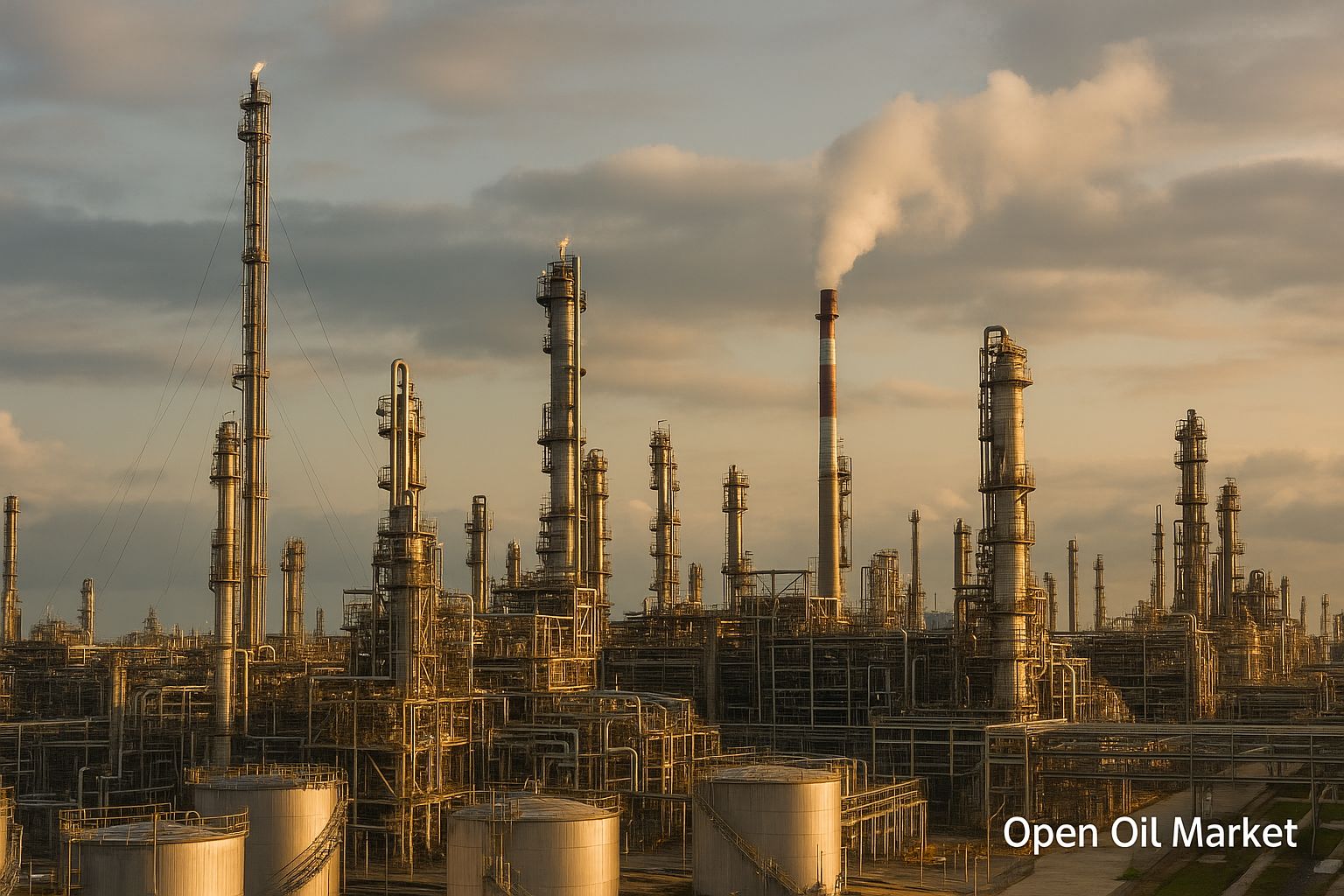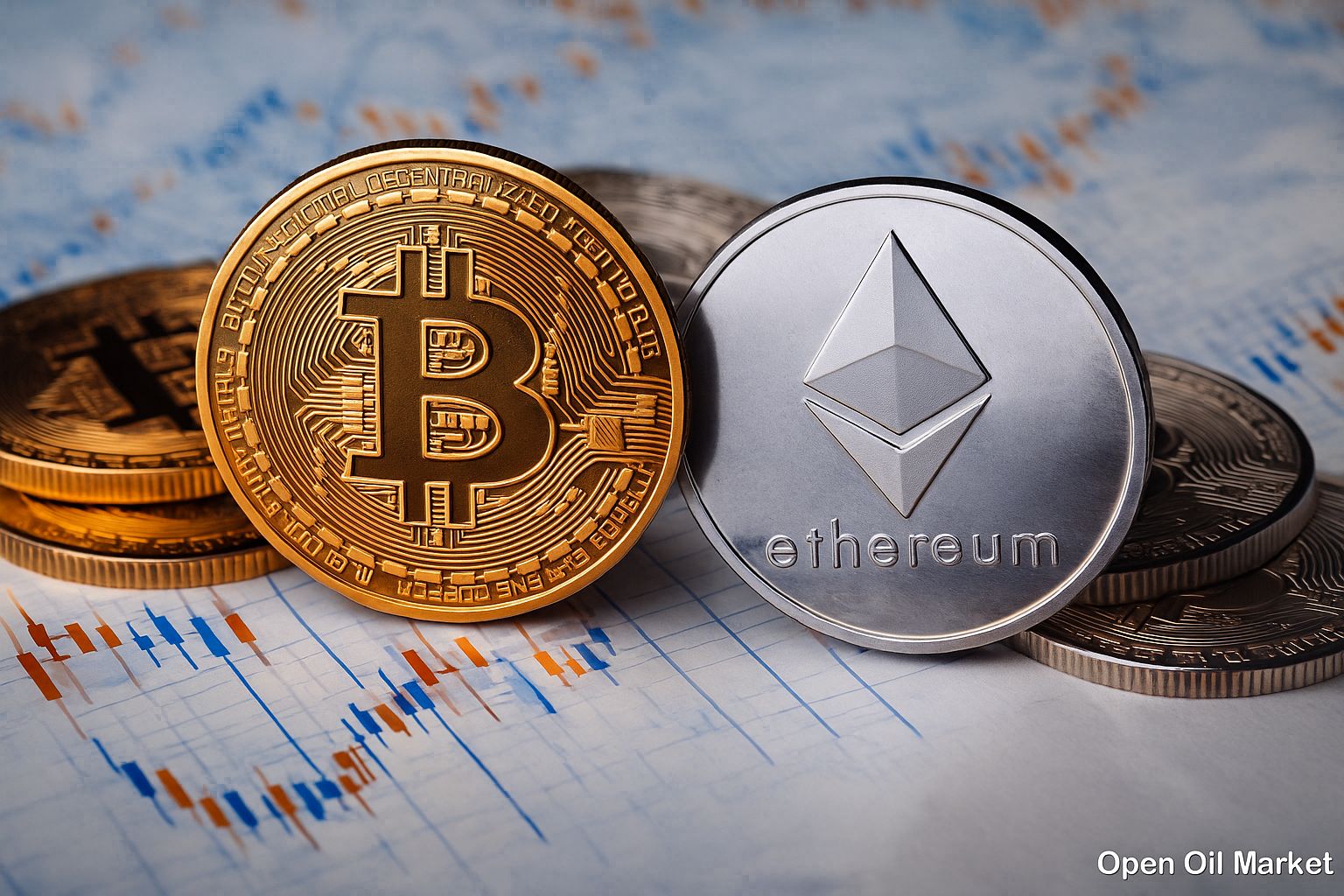
Current Energy Sector News for Thursday, 16 October 2025: Oil Prices at Record Lows, Stable Gas Market, Continued Sanction Pressure, and the Outcomes of the Energy Forum. Analysis by Open Oil Market.
As of mid-October 2025, the global fuel and energy sector is showing a relatively stable, yet ambiguous picture. Oil prices remain near several-month lows amid expectations of a supply surplus by the end of the year, while the geopolitical standoff between Russia and the West continues without signs of de-escalation. Sanction pressures on the Russian energy sector are intensifying—specifically, the UK has introduced new restrictions against Russian companies and its tanker fleet, maintaining the overall sanctions front and keeping Russian exports under pressure.
Meanwhile, Europe is entering winter with unprecedented gas reserves, ensuring price stability in the market, provided that no extreme cold weather occurs. The global energy transition is gaining momentum: record investments in renewable energy are being recorded, although traditional resources continue to play a critical role as a safety net. In Russia, emergency measures to stabilise the domestic oil products market are already showing effects—fuel shortages are decreasing, and wholesale prices are retreating from peaks. Focus remains on the ongoing International Forum “Russian Energy Week 2025” (15-17 October) in Moscow, where key topics include securing the domestic energy resource market and reorienting exports under new sanction conditions. Below is an overview of key events and trends in the sector as of 16 October 2025, important for investors, market participants, and oil and gas companies.
Domestic Fuel Market: Normalisation and Market Support
Following the acute fuel crisis in September, the situation in the domestic oil products market is gradually normalising. In most regions of Russia, the gasoline shortage has been eliminated: wholesale prices have significantly retreated from record levels, and independent petrol stations have resumed uninterrupted fuel sales. However, in regions far from major oil refineries (the Far East, certain Siberian entities), supply remains tense—authorities are maintaining control over the situation by extending restrictions and implementing new market support measures.
- Emergency Measures and Import: The Russian government has extended the temporary ban on the export of automotive gasoline until 31 December 2025, as well as maintained restrictions on the export of diesel fuel for independent suppliers until the end of the year. These steps allow for the redirection of maximum volumes of fuel to the domestic market. Simultaneously, attracting external resources is under consideration: discussions are taking place regarding the temporary removal of import duties to simplify gasoline and diesel imports (for example, from Belarusian refineries) to meet the needs of remote regions.
- Price Dampening and Control: A moratorium on the removal of the fuel damping mechanism has been in place since 1 October—the government continues to pay refiners compensation for supplies to the domestic market, even if exchange prices for fuel exceed threshold levels. This has maintained economic motivation to direct gasoline and diesel to petrol stations within the country. At the same time, the Federal Antimonopoly Service and the Ministry of Energy have intensified price monitoring; several petrol station networks have received warnings for unjustified price increases. Although direct state regulation of retail prices is being avoided, targeted market support mechanisms are proposed instead of price freezes.
- Initial Results: By mid-October, the deficit of motor fuel in the country has significantly decreased. The completion of unscheduled repairs at refineries and the redirection of export volumes to the domestic market have allowed for increased wholesale shipments to the most affected regions. In central and southern areas, gasoline and diesel stocks at depots and petrol stations are returning to normal. The government hopes to navigate the upcoming winter period without major supply disruptions, although the situation requires ongoing monitoring and readiness for additional interventions if necessary.
Commentary. The government’s actions to stabilise the market have been timely and necessary, notes Sergey Tereshkin, General Director of the fuel products marketplace Open Oil Market. According to him, maintaining damping payments while prices remain high and stringent export restrictions have helped saturate the domestic market and alleviate the acute nature of the crisis. In the future, beyond manual regulation, the sector requires systematic development of infrastructure—particularly the implementation of digital platforms for wholesale fuel trading—to enhance transparency in resource distribution across regions and prevent a recurrence of similar situations in the future.
Oil Market: Price Lows, Excess Supply, and Sanction Risks
Global oil prices are holding at their lowest levels in recent months during the second decade of October. The benchmark brand Brent is trading around $62–64 per barrel, while American WTI is trading at $58–60, significantly lower than the year’s highs (~$80 in spring). The market is pricing in a scenario of excess supply by the end of 2025, hence quotes remain under pressure despite a brief uptick a month earlier.
- Supply and Demand Balance: OPEC+ countries are adhering to a plan for gradual production increases. At the meeting on 5 October, the alliance confirmed an increase in the total quota from November of approximately +130–140 thousand barrels per day, continuing a cautious return to lost market shares. Concurrently, global oil demand is growing slower than expected. The International Energy Agency, in its October report, revised down the forecast for demand growth in 2025 to approximately 710 thousand barrels per day (compared to the previously estimated ~740 thousand), citing economic slowdowns in Europe and China. OPEC also expects modest growth (~+1.2 million b/d), while production outside of OPEC (particularly in the US, Brazil, and Guyana) is increasing at an accelerated pace. As a result, analysts are warning of the likelihood of oil oversupply in the global market in Q4, which keeps prices at the lower threshold.
- Sanctions and Geopolitics: Western sanctions remain a significant uncertainty factor for the oil sector. Earlier this year, a decrease in the price cap on Russian oil to $47.6 per barrel came into effect (as part of the 18th EU sanctions package), and new restrictions are currently under discussion. Washington is urging allies to completely abandon purchases of Russian oil and to block sanction evasion schemes via the ‘shadow fleet’ of tankers. Any tightening of sanctions could reduce available supply on the global market and induce a new wave of price volatility—especially if coinciding with other risk factors. Further nervousness is also maintained by international conflicts: despite a temporary easing in the Middle East, the situation in the region remains unstable, and the armed conflict in Ukraine continues. Recent drone attacks on oil infrastructure (including a fire at an oil depot in Crimea) have underlined the vulnerability of supplies. Thus, the geopolitical premium has not entirely disappeared and could raise quotes again in the event of an escalation.
- New Markets: Despite unprecedented sanctions, Russia has managed to maintain the bulk of its oil exports by redirecting supplies from Europe to other avenues. **India** and **China** have significantly increased their purchases of Russian oil at discounted prices; traders estimate that approximately 30% of India’s oil imports are now sourced from Russian barrels. The flow of supplies is also increasing to **Turkey**, Middle Eastern countries, and **Africa**. This reorientation supports the revenues of the Russian energy sector and partly balances the global market, although it requires substantial discounts and more complex logistics. In the event of further sanctions intensification (such as the introduction of secondary measures against carriers or buyers), these alternative sales channels could narrow, posing a new challenge for Russia’s oil sector.
Natural Gas: Record Reserves, Price Stability, and Export Restructuring
The situation in the global gas market ahead of winter is favourable for consumers. The European Union is entering the heating season with record gas reserves: underground storage facilities across the EU are filled to an average of over 95% of maximum capacity—significantly higher than last autumn's levels. Thanks to mild weather and high LNG supplies, Europe has managed to create a solid ‘safety cushion’ without emergency purchases, compensating for the sharp decrease in pipeline supplies from Russia. Wholesale gas prices remain at relatively low levels: the Dutch hub TTF is trading in the range of ~€30–35/MWh, which is several times lower than the peak values of autumn 2022. So far, demand in the autumn remains moderate, and the market remains stable, significantly reducing the risks of a repeat of last year's price crisis.
- Europe's Exit from Russian Gas: European countries continue to pursue a rapid reduction of their dependence on Russian gas. Direct pipeline supplies from Russia have fallen to symbolic volumes and are maintained only by a few states (e.g., Hungary) under long-term contracts. The EU plans to legally cement a complete exit from Russian energy carriers in the medium term: in the draft 19th sanctions package, a ban on imports of Russian LNG by 2026-2027 is being discussed. Already, Russia’s share in the EU gas import structure has decreased from ~40% to less than 15% over the past two years, and in the coming years, imports from Russia may be reduced to zero.
- Russia’s Eastern Turn: Having lost most European markets, Russia is increasing gas exports to the East. Supplies via the Power of Siberia gas pipeline to China continue to increase, potentially reaching a record ~22 billion cubic metres in 2025—close to the pipeline’s designed capacity. Simultaneously, negotiations are under way to construct a second phase of the pipeline through Mongolia (“Power of Siberia 2”), which by the end of the decade will partially replace the volumes lost from Europe. Additionally, Russia is expanding its LNG exports, launching new liquefaction projects in Yamal and the Far East. Additional shipments of Russian LNG are already headed to India, China, Bangladesh, and other countries. However, in the short term, overall gas exports from Russia remain below pre-sanction levels—Moscow’s priority at present is the domestic market and the needs of CIS partners.
Electric Power: Record Consumption and Infrastructure Modernisation
Global electricity consumption in 2025 continues to set historical highs. Economic growth, the development of digital technologies, and the mass electrification of transport are driving the demand for electricity in all regions of the world. According to industry analysts' forecasts, the total electricity generation globally this year will exceed 30,000 TWh for the first time—an unprecedented level. The largest economies are making the most significant contributions: the **US** is expected to consume around 4.1 trillion kWh (a new record for the country), while **China** will exceed 8.5 trillion kWh. Rapid growth in electricity consumption is also occurring in developing countries in Asia, Africa, and the Middle East due to industrialisation and population growth.
- Grid Load: The rapid growth in electricity consumption requires proactive modernisation of electrical infrastructure. Many countries have announced extensive investment programmes for expanding and updating energy systems, as well as constructing new generating capacities—to prevent energy shortages and outages during peak loads. For instance, in the US, energy companies are investing billions of dollars in strengthening distribution networks amid increased loads from data centres and electric vehicle charging stations. Similar projects to enhance energy grids are being implemented in Europe, China, and India. Concurrently, the role of intelligent ‘smart’ grids and energy storage systems is increasing: industrial battery farms and pumped storage plants will help flexibly manage loads and integrate the increasing generation from renewable sources.
Renewable Energy: Record Investments, Support, and New Challenges
The renewable energy sector (RES) in 2025 is demonstrating impressive growth, continuing the global trend towards a ‘green’ transformation of the energy sector. Investments in solar and wind energy, as well as related clean technologies, are breaking records. In the first six months of 2025 alone, approximately $400 billion has been invested globally in RES projects—10-12% more than during the same period last year. These funds are primarily directed towards constructing new solar and wind power plants, establishing energy storage systems, and digitising grids to integrate distributed generation. The large-scale commissioning of new capacities allows for increasing electricity production without raising greenhouse gas emissions.
- Share of Clean Energy: Renewable sources are occupying an increasingly significant place in the global energy balance. On average, around 30% of electricity generation worldwide is now provided by RES. In the EU, this figure has exceeded 45% thanks to active climate policies and the closure of coal-fired power plants. **China** is approaching the 30% generation mark from RES, despite the enormous scale of its energy system and the continued construction of new coal plants. For the first time in 2025, global electricity generation from solar and wind has surpassed generation from coal—a significant symbolic milestone for the energy sector.
- Government Support and Initiatives: The largest economies’ governments are strengthening support for ‘green’ energy. In Europe, new climate targets have been adopted, demanding accelerated commissioning of clean capacities and the development of carbon quota trading. In the US, measures to stimulate RES and related sectors continue to be implemented (tax incentives and subsidies under the Inflation Reduction Act, IRA). In the CIS countries, initiatives are also being launched: Russia and Kazakhstan are holding RES DPM competitions to select solar and wind projects, while Uzbekistan is building large solar parks in desert regions. This support is intended to reduce the industry’s costs and attract new investments, accelerating the transition to clean energy.
- Growth Challenges: The rapid growth of RES is accompanied by a number of issues. High demand for equipment and raw materials (for example, polysilicon for solar panels) leads to rising project costs and pressures on supply chains. The industry also faces a shortage of qualified personnel for the construction and operation of hundreds of new facilities worldwide. Additionally, energy systems require high flexibility: integrating large volumes of variable generation necessitates accelerated development of energy storage systems and smart load management. Despite these challenges, the global course towards decarbonisation remains firm—further growth in investments in RES and record shares of clean energy in the energy sector is anticipated.
Coal Market: Asian Demand and Gradual Shift Away from Coal
The global coal market in 2025 is characterised by mixed trends. In several Asian countries, demand for coal remains high and even increases in certain areas. This summer saw a spike in imports of thermal coal in East Asia: for example, in August, **China**, **Japan**, and **South Korea** collectively increased purchases by almost 20% compared to the previous month. Domestic factors were at play: in China, intensified environmental inspections and safety requirements temporarily reduced coal production, while industrial energy consumption was rapidly rising. China compensated for the missing generation through additional coal imports, driving regional prices up: Australian Newcastle coal rose above $110 per tonne (the highest in the last 5 months). Similarly, **India** and other developing economies increased their coal consumption to support the stability of energy systems during peak periods.
However, the long-term outlook for the coal industry remains unfavourable. More and more nations are pursuing policies to phase out coal for environmental reasons and to reduce emissions. The share of coal generation in the EU has dropped below 10% (several years ago it was around 15%), and 11 EU countries intend to completely close all coal-fired power plants by 2030, replacing them with gas and renewable capacities. In the US, despite targeted measures to support coal producers, market conditions are also unfavourable for coal: cheap natural gas and the rapid growth of RES continue to displace coal from the energy mix. Even traditionally coal-dependent countries are reducing their consumption—Germany, for example, after a temporary increase in coal burning in 2022-2023, has again reduced electricity production from coal-fired power plants in 2025.
- Reorientation of Exports from Russia: For Russia, one of the largest coal exporters, global trends mean a shift in primary markets. After the EU embargo in 2022, Russian coal companies redirected supplies to Asia. Currently, over 75% of Russian coal exports go to **China**, **India**, **Turkey**, and other Asia-Pacific countries. This demand partially compensates for the loss of the European market, although trading with distant countries requires offering discounts and increases logistic costs. In the long term, as major world economies increasingly phase out coal, Russian coal producers will need to adapt—exploring new markets and enhancing efficiency to remain competitive.
Forecasts and Perspectives: Cooperation at the Forum and Winter Risks
Overall, the energy sector is approaching the end of 2025 in a state of adaptation to new realities. The sanction standoff between Russia and the West continues to reshape global trade in energy resources. Fuel and energy companies are seeking ways to mitigate risks and explore new niches—be it redirecting exports to Asian markets or increasing the deep processing of raw materials within the country. Concurrently, the global energy transition is gaining momentum: record investments in RES and energy efficiency are shaping the long-term configuration of the sector. The coming months will show how successfully the winter trials can be navigated and how the balance of interests can be maintained during this challenging phase of 2025.
The International Forum “Russian Energy Week” (REN-2025), taking place in Moscow from 15-17 October under the slogan “Creating the Energy of the Future Together,” has become an important platform for discussing current challenges and prospects. Participants’ focus at REN is on ensuring the domestic energy resource market and realising Russia’s export potential under new conditions. An energy dialogue “Russia-OPEC” took place on the forum’s sidelines, with a special emphasis on strengthening cooperation between Russia and **Asia** and **Africa** in the energy sector. New agreements and partnerships targeting the development of the fuel and energy sector and expanding international cooperation are expected to be reached during the forum. The outcomes of the meeting of industry leaders will set the tone for further reforms and investments.
In general, investors and participants in the energy sector are concluding the year with cautious optimism—adaptation to new conditions continues, and the energy sector demonstrates resilience and readiness for change.




